Two Chinese blockbusters, “The Banquet” and “The Curse of Golden Flowers”, featuring Zhang Ziyi and Gong Li respectively, stirred the Oscar stage and China’s film industry at the end of 2006.
Controversial as they are, both films do have one thing worthy of credit: splendid Chinese costumes. The dressing and make-up of Zhang Ziyi and Gong Li is a mirror of Chinese fashion in the prosperous and open Tang Dynasty (618-907 AD).
Xi’an, the then capital Chang’an, was the Mecca of feminine fashion.
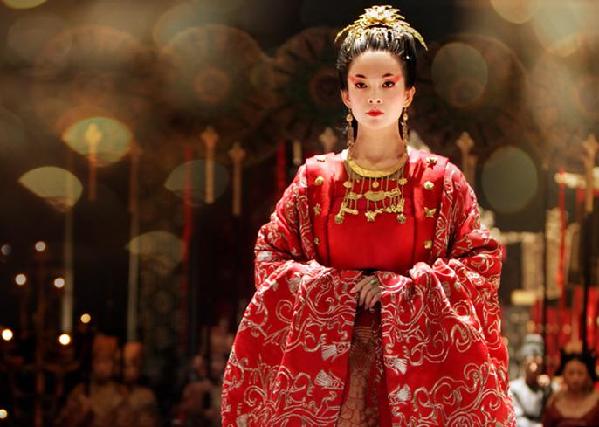 Zhang Ziyi in the “The Banquet”
Zhang Ziyi in the “The Banquet”

Costumes
In the Tang Chang’an, more than thousand years ago, lavishness was the rule of fashion.
Court ladies were among the trendsetters. They preferred loose and light costumes elaborately embroidered with exquisite patterns, highlighting feminine elegance.
Besides gauzy silk and satin, feather could even be used to make skirts. A Tang princess was reported to have ordered a hunt for all the rare birds in the woods and had the feather interwoven. Seen from different angles or put in or out of shade, it took on different colors.

Wider Collar: Beautiful and Dignified
The hundred-year old Cosmopolitan Magazine is the barometer of the latest fashion. Its cover girls usually have a third of their chests exposed. The V-shaped collar of Helen Mirren, who won a best actress Oscar in 2007 for her role in “The Queen”, might represent the standard of Cosmo.
A millennium ago, wider collars were also in style with fashionable Tang women. The collar of a Tang figurine is measured at 0.26 m in depth and 0.24 m in width.
Make-up
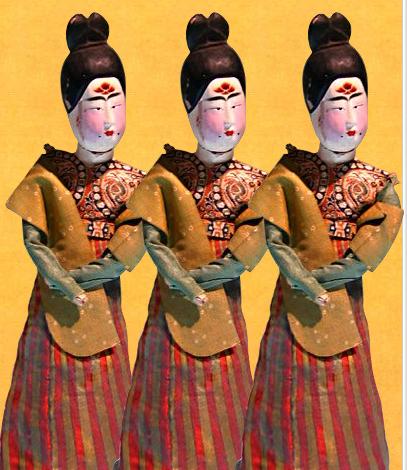
Look at this wooden figurine unearthed in a Tang tomb more than one thousand years ago! The passage of time never tarnished its original luster.
She has a powdered face, rouged cheeks and lips, bold and thick eyebrows, and gaudy ornaments between her eyebrows and at her temples.
The colorful and audacious make-up this figurine wears provides a glimpse of Tang women’s cosmetic fashion.
Fashion is almost a fulltime job for women, both in ancient and modern times. It could not be more stunning to find that fashionable Tang women and today’s trendsetters do share some similarities in cosmetic taste.
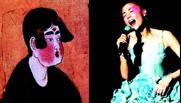
Tang women considered it in vogue to tough their cheeks brightly red. This flamboyant color even reached the eyelids and ears. More than aesthetically appealing, it resembled blush and was indicative of femininity.
Chinese singer Wang Fei established herself as the fashion leader years ago with her “suntan” make-up. Is it possible that she got the inspiration from the Tang beauties?
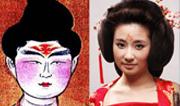
Eyebrows are the last thing to be forgotten when we are doing make-up today. So it was in the Tang Dynasty.
In search of novelty, women went to great lengths to work various shapes put of their eyebrows, ranging from willow-leaf to extremely broad and thick style. No later dynasties in China could match it in its taste of eyebrow designs.
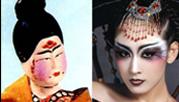 Have you ever seen the pasting of ornaments between eyebrows? It was a fashion trend in the Tang Dynasty, and its legacy is still with us today.
Have you ever seen the pasting of ornaments between eyebrows? It was a fashion trend in the Tang Dynasty, and its legacy is still with us today.
The least intricate was soybean-size dots. Yet, the most notable was plum-blossom patterns. Legend has it that in time before the Tang, a plum blossom fell on the forehead of a princess when she was lying under a tree, leaving an eye-pleasing imprint. It impressed the court ladies so much that they cut pink paper into the shape of plum blossoms to paste on their own foreheads.
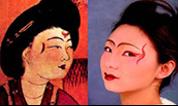
Tang women adorned nearly every part of their faces in rich colors. Their temples were no exception: they painted them red in crescent patterns.
It was said that much earlier than the Tang Dynasty, a favorite concubine of an emperor became even more adored after she accidentally injured her head, scarring the left side of her face. Thereafter, red crescent patterns on the side of the face became a standard cosmetic feature, indicating femininity.
